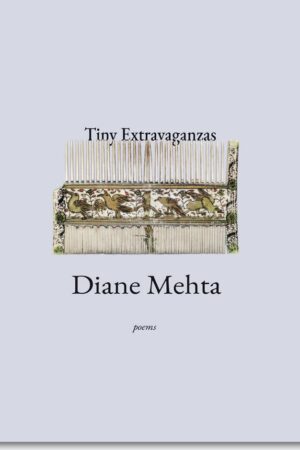Tiny Extravaganzas
by Diane Mehta
reviewed by Rhony Bhopla
“What is love?” This age-old question is the main query of Diane Mehta’s Tiny Extravaganzas. In these eloquent poems, Mehta responds to this question, and to artworks, with a tempered euphoria. The final quatrain from “Pot-pourri à Vaisseau, From Sèvres,” for instance, reads more like the beginning of a poem than the ending:
Art is love modeled in experience
fired at higher temperatures than experience.
Beauty elucidates what you hand-work in your heart;
making art is just that next and next experience of showing up.
Here, Mehta alludes to the practice of firing clay in a kiln at a heat beyond the human body’s tolerance. The motif of fire in this poem helps elucidates the relationship of love to art.
Another poem, “Willem de Kooning’s Woman I,” does the same, uncovering the complexity of art and artmaking in the process. Mehta exposes the male gaze by describing the repulsion of viewers who see the Dutch artist’s portrayal of the female figure. She is a “terrorizing doll of clashing lines and no perspective.” This criticism of the male artist is reminiscent of Christina Rossetti’s poem “In an Artist’s Studio.” Both poets gesture toward empowerment through language. Mehta, however, departs from Rossetti. For her, love of art and love of the process of making art is a confounding engagement. Mehta begins in a first-person point of view:
Again that day when I drop everything and train it midtown
to see her, my still-life mind eager for her distorted
gloss of figuration unfiguring herself, figuring out something
else beyond fieldscapes made of lines de Kooning puzzled out
so long before he jigsawed them along the contours of a woman
he refined, then scraped apart to reconstruct her once again.
Love lies in the act of painting rather than in the final depiction of a woman. Through this poem, Mehta opens the artwork up to wider interpretation. In the following stanza, Mehta uses polyptoton (a figure of speech that uses the repetition of words derived from the same root) with the word defining as an amplification of define. The enjambment after figure forces us to pause and subsequently, the words defining and define so little operate in contradistinction:
All the matrices and semi-precious colors defining her figure
define so little that she recedes into the canvas as if engraved
and remains below the lines and curves of what we think a woman is⏤Some passersby ooh and then, on closer look, appear repulsed
at this terrorizing doll of clashing lines and no perspective
but I see all the perspectives all at once.
If you construct a woman who refuses to cohere in an abstract field,
there’s no end to what you’ll find between her ribs, inside her
clawtooth mouth, behind her many angled eyes forever open with surprise.
The seamless turns are interrupted by a sudden declarative: “but I see all the perspectives all at once.” Fusion of the literal and visual becomes a single unit in the poet’s imagination and, perhaps, manifests her own artistic intentions.
If the collection’s throughline is “love,” the objects of the poet’s affection are many: art, family, language, heritage, and the natural world. In this stanza from “Racket on the Petals,” we enter a microcosm:
So, the flower alone meets creatures in habit and habitat,
burdened by its scent, its silhouette all season
petaling and unpetaling, swarms of butterflies
doing as they please; no disaster, but what a racket
on the petals, bee-loud wings and hummingbirds vibrating.
Through conjoined words like bee-loud and double-bloom, Mehta implies breakage at the same time as visuality. The wings are loud, but the hyphenated bee-loud creates an effect of synesthesia. Meanwhile, when the narrator of the “Rock Garden in the Back Yard with a Ghost Tree and an Evergreen” points to her own culpability in destroying the natural world, the poem becomes ecopoetic:
It is time to fell the stump of this dead tree blossoming
spores and fungi as if saying what happens was never up to me.
I lift the axe high above my head. My son sees how a body
yields to murder and clears out rot in the same motion.
While the speaker’s son presumably is the ultimate object of affection, the poem does not spare him from experiencing what the poet feels: that violence and love coexist.
Tiny Extravaganzas is an assemblage of responses to original artworks and personal experiences, much like the transmedial works of Yusef Komunyakaa and Ricardo Pau-Llosa. The collection reveals a level of inquiry wrought of yearning and pleasure, observation and reflection. Diane Mehta’s poems bring us close to the fire of love, the coolness of respite, and most of all, the rapturous pursuit of enigma.
Published on February 29, 2024

